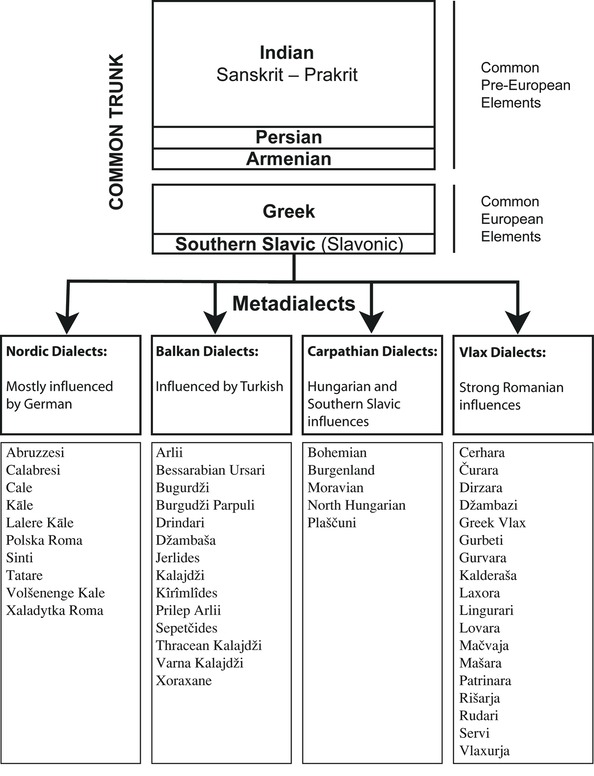A Layered Structure
Romanes shows a layered structure of acquisitions. It reflects the various influences which occurred during the Roma migration. These layers are common to all Romanes dialects and provide the common homogenous stock on which all dialects are built. All Romanes dialects and variants contain this common trunk – including its grammar – to sometimes varying degrees of preservation.
The Common Trunk
An analysis of the lexems in the common trunk shows that the bulk of the pre-European ones are Indian. Most interesting is that this Indian vocabulary encompasses a large part of the everyday needs as well as of course, most of the grammar. In comparison to the plethora of Indian words, there are only few Persian and Armenian lexemes, although such important ones such as a horse, graj or a carriage, vurdon are from these origins; in fact many of the terms which concern travels are of Persian origins. Very few pre-European lexeme of other origins are found in Romanes. One finds a few words of Kurdish origins such as avsin, absin [steel]; kutši [pot]; xulaj [owner, high-ranking person]; and even a few Georgian one such as khoni [fat] and khilav [plum].

In terms of the European common trunk, Greek as we have already noted forms a very important part of Romanes and one also finds many Southern Slavic lexems.
It is rather difficult to assess the number or even the proportion of words of various origins in different Roma dialects. Local – and even personal peculiarities make counting almost impossible. However, we can broadly say – from such various examples such as the Crimean Romanes, the Kalderaša and Carpathian dialects that the common trunk makes about 50 to 60% of the vocabulary. The general problem when assessing this proportion is which vocabulary basis one chooses as many local words – especially concerning the new realities and new trades are always in the local language.
The Next Level
From this common trunk, we can pass to the next level, namely, the creation of metadialects. Metadialects – and their associated structures metagroups are “conceptual” entities. These structures allow one to see connections between the different groups and, in terms of language, represent the next stage of acquisitions above the common trunk – that is the first new acquisitions above that level.
These metadialects are the result of the migrations and history of the different Roma groups and we will describe them in more details while discussing and describing the group structure of Roma. There are 4 metadialect groups: The Vlax dialects, the Carpathian dialects, the Nordic dialects and of course, the Balkan dialects. Each corresponds to a migration inside Europe – from the Balkanic base of the Roma. With the exception of course of the Balkanic dialects, namely the ones spoken by Roma who have remained in that region throughout their European history.
In the figure, we have represented the first layer of acquisitions above the common trunk. For Nordic dialects, one finds a first (sometimes-shallow) layer of German, for Carpathian, a first layer of Hungarian words, for the Vlax of course the ubiquitous Romanian and finally, for the Balkanic dialects, Turkish influences. Note that these distinctions – with a geographical connotation – do not represent the nowadays geographical spread of these dialects. After all, the “archetypal” Vlax dialect of the Kalderaša is nowadays spoken all over the world as a result of recent migrations of this group of Roma.